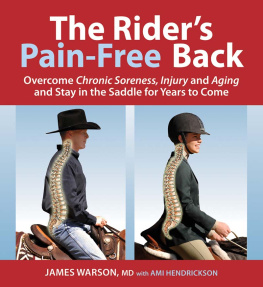In a small town in Germany lives a man who breeds horses. Nothing remarkable in that. He also breaks them in and competes on them. Nothing remarkable in that either. Like all breeders and riders his horses have their fair share of problems. What makes this person special is that his horses never have back problems! Not through luck, lack of judgement, and certainly not through ignorance; this is simply a horseman who has an overwhelming sense of responsibility towards the movements of the horse to preserve their natural rhythm and flow, whatever the level of training and whatever the type of work. There are no concessions to rider error, no concessions to the degree of collection. Short, fumbling strides are not only unacceptable, they are inexcusable. The horse must carry its rider willingly forwards, with a back that is soft and supple, and limbs that swing freely and comfortably. Whether it takes twenty minutes or two hours, the horse does not return to the stable until its back moves with Schwung.
It has taken me a whole veterinary degree and twelve years of treating horses with back disorders, to appreciate fully the importance of Schwung. It is the most fundamental characteristic of the horses natural movements, and the quality most easily lost as soon as the horse has to carry a rider. This book has come into being because one man in Germany insisted that his horses backs never lost their swing!
Introduction
If you prick us, do we not bleed? If you tickle us, do we not laugh? And if you wrong us, shall we not revenge?
William Shakespeare: The Merchant of Venice
In the thirteenth century, Mongolian warriors rode thousands of miles across Asia on horseback. To tenderize their meat, they used to put large slabs of it under their saddles. Did their horses all end up with back problems? The answer is, probably not as many as those horses of ours that work for only a few hours a week, but in enclosed spaces and on entirely unsuitable surfaces, or else spend a great deal of time standing on one spot in the confines of a stable. Its all a question of balance: physical balance, mental balance, emotional balance and, who knows, probably spiritual balance as well.
In human medicine, back pain is often regarded as something of an enigma. There are sources of back pain such as slipped discs, fractures, compression of the spinal cord, or arthritis which can be demonstrated by modern imaging techniques, but what about those subtle variations in muscle tone, or slight deviations in posture? Small areas of muscle tension cannot be made visible by X-rays, yet they may significantly interrupt the flow of information between a muscle and its nerve, and thus restrict the freedom of movement throughout the whole body.
The presence of back pain in horses is disputed, both among riders and veterinarians. It shouldnt be. Pain is a nerve signal which is transmitted when specific chemicals are released in tissue that is threatened or damaged. This can happen in a back, just as it happens in a leg or a foot. However, when the painful site is in the horses back, close to the spinal cord which is a direct link to the brain, and yet the horse is conditioned to show basic obedience to the rider, the behavioural expression of that pain can be extremely varied. Acute pain can lead to the most exaggerated response, like bolting or rearing; chronic pain can be suppressed to the extent that it is hard to demonstrate the existence of a problem at all. In horses, the enigma is not so much in the pain but in its cause. What was the situation that led to the misunderstanding, that caused the imbalance, that resulted in the damage, that triggered the signal? At what point did the problem become the pain?
Back pain is not new. Treatment of human back pain has preoccupied civilizations for centuries. At present, in the twentieth century, our treatment is largely based on chemical pain control or surgery, yet previous civilizations developed entire philosophies of life to explain the phenomenon of pain in the human back. These philosophies went far beyond any simple medical definition. The great, ancient civilizations of the world all regarded the back as an interface between the living energy of the human being and the energy of the world around him. The backs physical health depended on the humans mental, emotional and spiritual state. If there was no pain, the body must be in harmony with its surroundings; if there was pain, the body must be at odds, either with its emotions, or with its life-style.
Today, more working hours are lost to industry through back pain than through any other cause. Although we are beginning to realize the importance of postural comfort, both at home, in the car, and in the workplace, our high-speed, high-tech life-style doesnt always allow sufficient time for us to put this knowledge into practice. Not so very long ago, one way to close the door on the pressures of a hectic environment was to enter into the company of a horse, to experience the world from the vantage point of an animal with a single-horse-power engine and a top speed of 30 m.p.h. Now it seems we have drawn the horse into our own world: instead of leaving behind our own busy schedules, we simply add our horses to the agenda, fitting them into an already overflowing timetable.
It is therefore almost inevitable that the horses back should come under the influence of the same problems that affect his human partner. The whole anatomy of the human spine acts directly upon that of the horse. It transmits the commands for equestrianism, but it cannot help transmitting a whole range of human emotions at the same time. We all know that a riders anxiety will be felt through the saddle, and that a plod may wake up under an electric backside, but the spectrum of human emotion is much wider than this, and the horse is a very sensitive recipient.
Diagnosing back problems in horses is not without its difficulties because so many factors have to be taken into consideration. For example, humans are free to take off any shoes or clothing that make them feel uncomfortable. The horse can only try to communicate his discomfort by changing the way he moves, or by making small changes to his facial expression. If early signs of discomfort are overlooked, the symptoms can accumulate until the back is thrown out of balance. The result is a back problem, even though the source is not necessarily in the back.
Producing hard, visual evidence for every case of suspected back pain in horses is usually beyond the scope of general veterinary practice, and often beyond the financial scope of many horse owners. The sophisticated diagnostic procedures used in human medicine are available for horses, but because of the size of the patient and the cost of the equipment, they are only to be found at specialist equine clinics. Enter the back person. Once upon a time this was someone who manually adjusted elements of the horses spine using a basic knowledge of levers. Nowadays, a back person may be any one of a number of therapists, who not only manipulate without apparent physical force but who talk of harmonizing energy and expanding auras!











